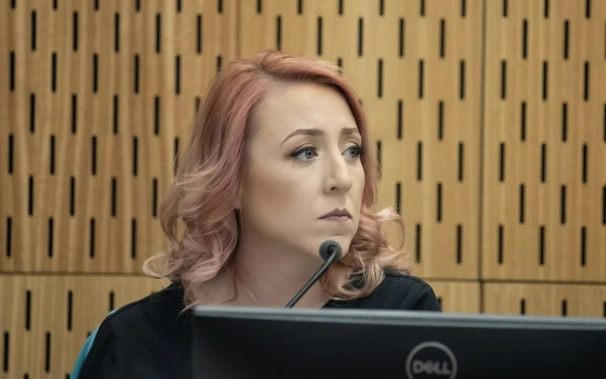
By Danielle Clent of RNZ
A police dispatcher would have sent units to immediately evacuate Linwood Islamic Centre on the day of the Christchurch terror attack if she was aware of a threat, an inquest has heard.
A lawyer also requested a short adjournment after another witness became distressed while reading her statement to the court.
Police constable Dara Taylor was working as the channel 1 dispatcher on the day of the Al Noor Mosque and Linwood Islamic Centre attacks which ended in the murder of 51 worshippers.
It was not until four days after the massacre that she became aware of the 111 call that had been made by a parliamentary staffer who was sent Brenton Tarrant’s manifesto.
Earlier evidence in the inquest showed the staffer’s call was categorised as NATSEC (national security) priority 2.
The call-taker told the court she categorised it that way as it was an unusual call and it was not clear when and where the attack would take place.
At the same time as that call, priority 1 firearms events were populating Taylor’s screen and became her primary focus.
/cloudfront-ap-southeast-2.images.arcpublishing.com/nzme/DNK5HCU4ARHGPO45R3RQDSMZ5U.png)
Deputy chief Coroner Brigitte Windley. Photo / Iain McGregor
- Jack Tame: It speaks volumes that Winston refused to remove his demonstrably false statement
- March 15 inquest: 111 call made minutes after gunman's manifesto sent to PM
- ‘Could they have been saved?’ - Inquest into Christchurch terror attack begins as families ask for answers
Under cross-examination by counsel assisting the coroner Abigail Van Echten, Taylor said if she had the information which said Linwood mosque was a target, alongside knowing of the shooting at Al Noor Mosque, she would have acted quickly.
“Again this is with hindsight, would send someone there straight away to evacuate everyone in that mosque, and then clear and then have AOS there for if he showed up there.
“So I would not have just two officers standing outside just in case, it would be an evacuation.”
Had the parliamentary staffer’s call been categorised as a priority 1 event, Taylor said it was possible that she would have seen it while the attack was underway.
Taylor was also critical of the different systems police and ambulance used to relay information to each other about events.
Evidence shows that just one message was sent from police to St John about the attack, with Taylor saying it was more efficient to have people relaying information in person as they worked in the same communication centre.
“As ambulance operate on a slightly different database, it was drawn to my attention that day that Intercad was not efficient and that the messengers was more efficient to communicate. That is because ambulance do not operate on the same system as police and fire which … I don’t know why that is.”
/cloudfront-ap-southeast-2.images.arcpublishing.com/nzme/3ZOIUJGBMZBFHD33ZINQXUEP7A.png)
Counsel assisting the coroner Abigail Van Echten. Photo / Iain McGregor
She said she would be lying if she said it had not been an issue during other situations.
When asked if anything had been done to improve it, Taylor said she was not aware of anything except “the constant frustration by front-line staff and dispatchers”.
“But that would be my one takeaway from this, that ambulance get funding from the government to update that system so they are all the same.”
Recalling what it was like in the communication centre that day, Taylor said it was the most “chaotic” event she had experienced in her career, both as a sworn and non-sworn staff member.
Taylor said everyone in the communications centre who was not bound to a desk with a headset on was soon running around, relaying important information to team leaders and dispatchers.
Every free seat was quickly taken, she said.
“There was no idle hands,” she said, “everyone was finding work and making a response happen.”
/cloudfront-ap-southeast-2.images.arcpublishing.com/nzme/U7D7NX7MCFHQ7LBZGNRL2MFFC4.jpg)
The crowds that had gathered in Hagley Park, Christchurch. Photo / Alan Gibson
Police communicator distressed reading statement
The supervisor who was mentoring the junior call-taker who took the parliamentary staffer’s 111 call became so upset while giving her statement, a lawyer stood up and requested she be able to take a break.
The supervisor, who has name suppression, broke down in tears when she spoke of learning there was an active shooter in Christchurch.
She continued to try to speak before lawyer Kathryn Dalziel asked deputy chief Coroner Brigitte Windley if she could be given a break to calm down.
The supervisor continued her statement after a short break, saying she did not talk to anyone else about the 111 call given she had reported it to her supervisor and did not think she needed to do anything else about it.
She spent the rest of the day helping where needed, including calling schools and putting them into lockdown.
The inquest will examine the following 10 issues over the next six weeks:
- The events of March 15, 2019, from the commencement of the attack until the terrorist’s formal interview by police
- The response times and entry processes of police and ambulance officers at each mosque
- The triage and medical response at each mosque
- The steps that were taken to apprehend the offender
- The role of, and processes undertaken by, Christchurch Hospital in responding to the attack
- Co-ordination between emergency services and first responders
- Whether the terrorist had any direct assistance from any other person on March 15, 2019
- If raised by immediate family, and to the extent it can be ascertained, the final movements and time of death for each of the deceased
- The cause of death for each of the victims and whether any deaths could have been avoided
- Whether Al Noor Mosque emergency exit door in the southeast corner of the main prayer room failed to function during the attack and, if so, why?
The inquest continues.
- RNZ
Take your Radio, Podcasts and Music with you









